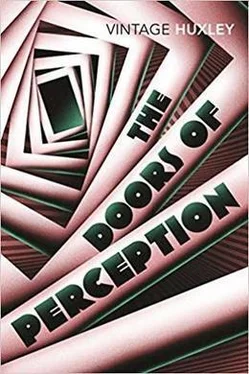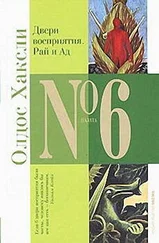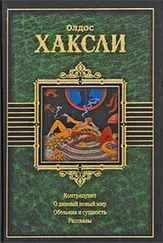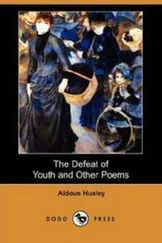In this context, how significant is the enormous heightening, under mescalin, of the perception of colour! For certain animals it is biologically very important to be able to distinguish certain hues. But beyond the limits of their utilitarian spectrum, most creatures are completely colour blind. Bees, for example, spend most of their time ‘deflowering the fresh virgins of the spring’; but, as von Frisch has shown, they can recognize only a very few colours. Man’s highly developed colour sense is a biological luxury—inestimably precious to him as an intellectual and spiritual being, but unnecessary to his survival as an animal. To judge by the adjectives which Homer puts into their mouths, the heroes of the Trojan War hardly excelled the bees in their capacity to distinguish colours. In this respect, at least, mankind’s advance has been prodigious.
Mescalin raises all colours to a higher power and makes the percipient aware of innumerable fine shades of difference, to which, at ordinary times, he is completely blind. It would seem that, for Mind at Large, the so–called secondary characters of things are primary. Unlike Locke, it evidently feels that colours are more important, better worth attending to than masses, positions and dimensions. Like mescalin takers, many mystics perceive supernaturally brilliant colours, not only with the inward eye, but even in the objective world around them. Similar reports are made by psychics and sensitives. There are certain mediums to whom the mescalin taker’s brief revelation is a matter, during long periods, of daily and hourly experience.
From this long but indispensable excursion into the realm of theory we may now return to the miraculous facts—four bamboo chair legs in the middle of a room. Like Wordsworth’s daffodils, they brought all manner of wealth—the gift, beyond price, of a new direct insight into the very Nature of Things, together with a more modest treasure of understanding in the field, especially, of the arts.
A rose is a rose is a rose. But these chair legs were chair legs were St Michael and all angels. Four or five hours after the event, when the effects of a cerebral sugar shortage were wearing off, I was taken for a little tour of the city, which included a visit, towards sundown, to what is modestly claimed to be The World’s Biggest Drug Store. At the Back of the W.B.D.S., among the toys, the greeting cards and comics stood a row, surprisingly enough, of art books. I picked up the first volume that came to hand. It was on Van Gogh, and the picture at which the book opened was The Chair —that astounding portrait of a Ding an Sich , which the mad painter saw, with a kind of adoring terror, and tried to render on his canvas. But it was a task to which the power even of genius proved wholly inadequate. The chair Van Gogh had seen was obviously the same in essence as the chair I had seen. But, though incomparably more real than the chair of ordinary perception, the chair in his picture remained no more than an unusually expressive symbol of the fact. The fact had been manifested Suchness; this was only an emblem. Such emblems are sources of true knowledge about the Nature of Things, and this true knowledge may serve to prepare the mind which accepts it for immediate insights on its own account. But that is all. However expressive, symbols can never be the things they stand for.
It would be interesting, in this context, to make a study of the works of art available to the great knowers of Suchness. What sort of pictures did Eckhart look at? What sculptures and paintings played a part in the religious experience of St John of the Cross, of Hakuin, of Hui–neng, of William Law? The questions are beyond my power to answer; but I strongly suspect that most of the great knowers of Suchness paid very little attention to art—some refusing to have anything to do with it at all, others being content with what a critical eye would regard as second–rate, or even tenth–rate, works. (To a person whose transfigured and transfiguring mind can see the All in every this , the first–rateness or tenth–rateness of even a religious painting will be a matter of the most sovereign indifference.) Art, I suppose, is only for beginners, or else for those resolute dead–enders, who have made up their minds to be content with the ersatz of Suchness, with symbols rather than with what they signify, with the elegantly composed recipe in lieu of actual dinner.
I returned the Van Gogh to its rack and picked up the volume standing next to it. It was a book on Botticelli. I turned the pages. The Birth of Venus —never one of my favourites. Venus and Mars , that loveliness so passionately denounced by poor Ruskin at the height of his long–drawn–out sexual tragedy. The marvellously rich and intricate Calumny of Apelles . And then a somewhat less familiar and not very good picture, Judith . My attention was arrested and I gazed in fascination, not at the pale neurotic heroine or her attendant, not at the victim’s hairy head or the vernal landscape in the background, but at the purplish silk of Judith’s pleated bodice and long wind–blown skirts.
This was something I had seen before—seen that very morning, between the flowers and the furniture, when I looked down by chance, and went on passionately staring by choice, at my own crossed legs. Those folds in the trousers—what a labyrinth of endlessly significant complexity! And the texture of the grey flannel—how rich, how deeply, mysteriously sumptuous! And here they were again, in Botticelli’s picture.
Civilized human beings wear clothes, therefore there can be no portraiture, no mythological or historical story telling without representations of folded textiles. But though it may account for the origins, mere tailoring can never explain the luxuriant development of drapery as a major theme of all the plastic arts. Artists, it is obvious, have always loved drapery for its own sake—or, rather, for their own. When you paint or carve drapery, you are painting or carving forms which, for all practical purposes, are non–representational—the kind of unconditioned forms on which artists even in the most naturalistic tradition like to let themselves go. In the average Madonna or Apostle the strictly human, fully representational element accounts for about ten per cent of the whole. All the rest consists of many coloured variations on the inexhaustible theme of crumpled wool or linen. And these non–representational nine–tenths of a Madonna or an Apostle may be just as important qualitatively as they are in quantity. Very often they set the tone of the whole work of art, they state the key in which the theme is being rendered, they express the mood, the temperament, the attitude to life of the artist. Stoical serenity reveals itself in the smooth surfaces, the broad untortured folds of Piero’s draperies. Torn between fact and wish, between cynicism and idealism, Bernini tempers the all but caricatural verisimilitude of his faces with enormous sartorial abstractions, which are the embodiment, in stone or bronze, of the everlasting commonplaces of rhetoric—the heroism, the holiness, the sublimity to which mankind perpetually aspires, for the most part in vain. And here are El Greco’s disquietingly visceral skirts and mantles; here are the sharp, twisting, flame–like folds in which Cosimo Tura clothes his figures: in the first, traditional spirituality breaks down into a nameless physiological yearning; in the second, there writhes an agonized sense of the world’s essential strangeness and hostility. Or consider Watteau; his men and women play lutes, get ready for balls and harlequinades, embark, on velvet lawns and under noble trees, for the Cythera of every lover’s dream; their enormous melancholy and the flayed, excruciating sensibility of their creator find expression, not in the actions recorded, not in the gestures and the faces portrayed, but in the relief and texture of their taffeta skirts, their satin capes and doublets. Not an inch of smooth surface here, not a moment of peace or confidence, only a silken wilderness of countless tiny pleats and wrinkles, with an incessant modulation—inner uncertainty rendered with the perfect assurance of a master hand—of tone into tone, of one indeterminate colour into another. In life, man proposes, God disposes. In the plastic arts the proposing is done by the subject matter; that which disposes is ultimately the artist’s temperament, proximately (at least in portraiture, history and genre) the carved or painted drapery. Between them these two may decree that a fête galante shall move to tears, that a crucifixion shall be serene to the point of cheerfulness, that a stigmatization shall be almost intolerably sexy, that the likeness of a prodigy of female brainlessness (I am thinking now of Ingres’ incomparable Mme Moitessier) shall express the austerest, the most uncompromising intellectuality.
Читать дальше



![Олдос Хаксли - О дивный новый мир [Прекрасный новый мир]](/books/11834/oldos-haksli-o-divnyj-novyj-mir-prekrasnyj-novyj-thumb.webp)






